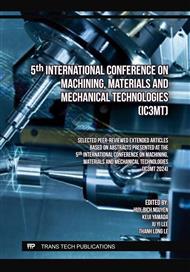p.45
p.53
p.61
p.69
p.75
p.83
p.93
p.107
p.117
Effect of Cutting Temperature on Material Deformation and Residual Stress after Face Milling
Abstract:
The utilization of hydrogen in the construction of a decarbonized society is expected to expand the application of austenitic stainless steels with high resistance to hydrogen embrittlement as structural materials. However, the residual stress generated during machining causes material deformation, leading to increased costs and decreased productivity. Therefore, cutting methods that can control residual stress are necessary, prompting numerous studies on residual stress. We proposed conditions to reduce deformation and clarify the relationship between the depth of cut and material deformation, as well as the relationship between residual stress and material thickness after machining. In this study, stainless steel (AISI 304) was face milled, and the relationship between the cutting temperature and material deformation after machining was evaluated, as in a previous study. In addition, electrolytic polishing was performed to measure the residual stress in the depth direction, and its relationship with material deformation was evaluated. The experimental results showed no correlation between the cutting temperature and deformation. However, the measurement of the residual stress in the depth direction suggests that the removal of the surface layer by electropolishing may affect material deformation and residual stress.
Info:
Periodical:
Pages:
83-89
Citation:
Online since:
March 2025
Authors:
Keywords:
Price:
Сopyright:
© 2025 Trans Tech Publications Ltd. All Rights Reserved
Share:
Citation:



